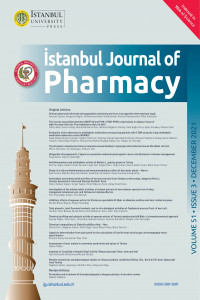Abstract
References
- Brummitt, R. K. (1992). Vascular plant families and genera. Richmond, UK: Royal Botanic Gardens, Kew.
- Davis, P. H. (1965). Flora of Turkey and the East Aegean Islands, (Vol. 1, pp.119-134). Edinburgh, UK: Edinburgh University Press.
- Evans, W. C. (2002). Trease and evans pharmacognosy. Philadelphia, USA: Saunders.
- Güner, A., Aslan, S., Ekim, T., Vural, M., & Babaç, M. T. (2012). Türkiye bitkileri listesi (Damarlı bitkiler) [Turkey plant list (Vascular plants)]. İstanbul, Türkiye: Nezahat Gökyigit Botanik Bahçesi Yayınları. Hao, D. C. (2018). Ranunculales medicinal plants: Biodiversity, chemodiversity and pharmacotherapy. London, UK: Academic Press.
- Heywood, V. H., Brummitt, R. K., Culham, A., & Seberg, O. (2007). Flowering plant families of the world. Ontario, Canada: Firefly Books.
- IPNI. (2021, January 05). International Plant Names Index. Retrieved from https://www.ipni.org/n/1000018-1
- Maxwell, F. B. (1893). A comparative study of the roots of Ranunculaceae. Botanical Gazette, 18(1), 8-16.
- Metcalfe, C. R., & Chalk, L. (1965). Anatomy of dicotyledones. (Vol. 2). Oxford, UK: Clarendon Press.
- POWO. (2021, January 05). Plants of the World Online. Retrieved from http://www.plantsoftheworldonline.org/taxon/urn:lsid:ipni. org:names:30000277-2
- Türk Farmakopesi (2017). Türk Farmakopesi, genel monograflar I [Turkish Pharmacopoeia, general monographs I]. Ankara, Türkiye: T.C. Sağlık Bakanlığı.
- Yentür, S. (1995). Bitki anatomisi [Plant anatomy]. İstanbul, Türkiye: İstanbul Üniversitesi Yayınları.
- Yin, T., Cai, L., & Ding, Z. (2020). A systematic review on the chemical constituents of the genus Consolida (Ranunculaceae) and their biological activities. RSC Advances, 10(58), 35072-35089.
Abstract
Background and Aims: Consolida orientalis (J.Gay.) Schrödinger belonging to the Ranunculaceae family, which is called “morçiçek” in Turkey. It can be recognized by its laciniae linear leaves, intense violet flower, and follicle fruit. The aim of the present study is to elucidate the anatomical properties of C. orientalis, as one of the medically important plant species of Ranunculaceae family. Methods: Plant material was collected from Kahramankazan (Ankara-Turkey). The samples were protected in 70% alcohol. The transverse and surface sections were investigated by light microscope and photographed. Results: The root is characterized by a periderm, pericyclic sclerenchymatous ring, and vessels embedded in sclerenchymatous pith cells. It was observed that in the anatomical features of the stem, the adaxial walls of epidermis cells curved outward and were covered with a thick cuticle layer. Moreover, stomata were observed in the epidermis and the stem had hairs only at the above parts, while other parts were bare. These hairs consisted of both glandular (with a long stalk) and non-glandular (unicellular, silicified) types. The leaf is broadly v-shaped, monofacial and has a 1-layer epidermis. Ranunculaceous stomata and non-glandular (unicellular, silicified and slightly bowed) hairs were observed on both surfaces. Conclusion: The root, stem, and leaf anatomy of C. orientalis was studied for the first time. The anatomical features described in detail with reference reports could be helpful in future taxonomic studies.
References
- Brummitt, R. K. (1992). Vascular plant families and genera. Richmond, UK: Royal Botanic Gardens, Kew.
- Davis, P. H. (1965). Flora of Turkey and the East Aegean Islands, (Vol. 1, pp.119-134). Edinburgh, UK: Edinburgh University Press.
- Evans, W. C. (2002). Trease and evans pharmacognosy. Philadelphia, USA: Saunders.
- Güner, A., Aslan, S., Ekim, T., Vural, M., & Babaç, M. T. (2012). Türkiye bitkileri listesi (Damarlı bitkiler) [Turkey plant list (Vascular plants)]. İstanbul, Türkiye: Nezahat Gökyigit Botanik Bahçesi Yayınları. Hao, D. C. (2018). Ranunculales medicinal plants: Biodiversity, chemodiversity and pharmacotherapy. London, UK: Academic Press.
- Heywood, V. H., Brummitt, R. K., Culham, A., & Seberg, O. (2007). Flowering plant families of the world. Ontario, Canada: Firefly Books.
- IPNI. (2021, January 05). International Plant Names Index. Retrieved from https://www.ipni.org/n/1000018-1
- Maxwell, F. B. (1893). A comparative study of the roots of Ranunculaceae. Botanical Gazette, 18(1), 8-16.
- Metcalfe, C. R., & Chalk, L. (1965). Anatomy of dicotyledones. (Vol. 2). Oxford, UK: Clarendon Press.
- POWO. (2021, January 05). Plants of the World Online. Retrieved from http://www.plantsoftheworldonline.org/taxon/urn:lsid:ipni. org:names:30000277-2
- Türk Farmakopesi (2017). Türk Farmakopesi, genel monograflar I [Turkish Pharmacopoeia, general monographs I]. Ankara, Türkiye: T.C. Sağlık Bakanlığı.
- Yentür, S. (1995). Bitki anatomisi [Plant anatomy]. İstanbul, Türkiye: İstanbul Üniversitesi Yayınları.
- Yin, T., Cai, L., & Ding, Z. (2020). A systematic review on the chemical constituents of the genus Consolida (Ranunculaceae) and their biological activities. RSC Advances, 10(58), 35072-35089.
Details
| Primary Language | English |
|---|---|
| Subjects | Pharmacology and Pharmaceutical Sciences |
| Journal Section | Original Article |
| Authors | |
| Publication Date | December 29, 2021 |
| Submission Date | February 16, 2021 |
| Published in Issue | Year 2021 Volume: 51 Issue: 3 |


